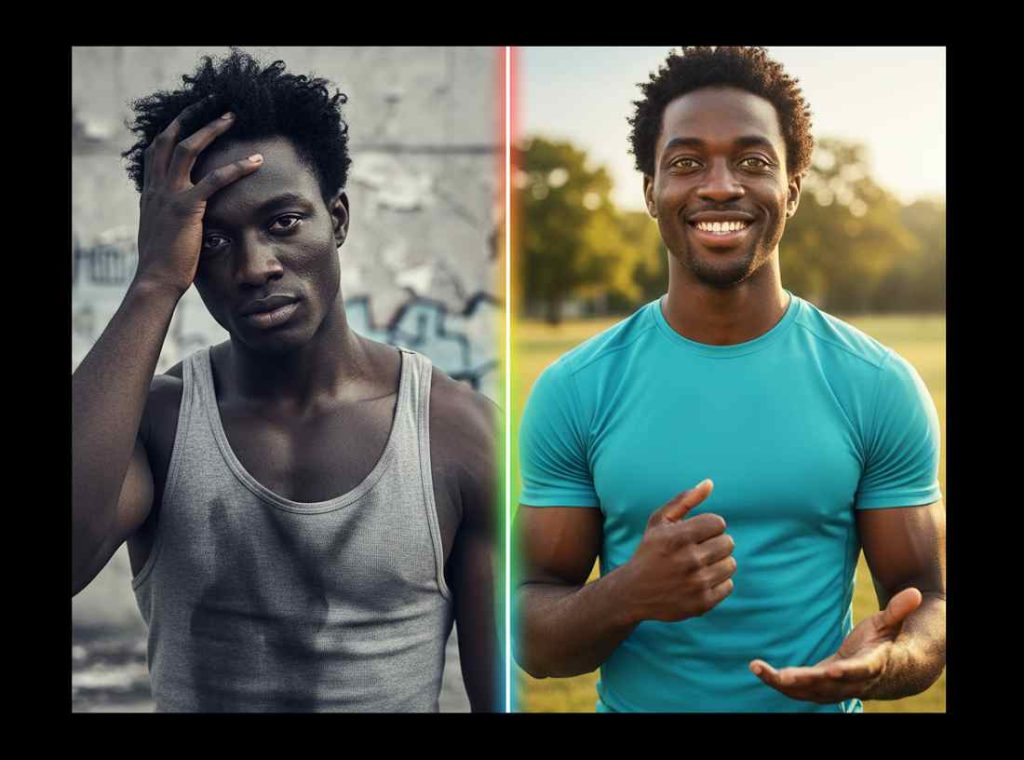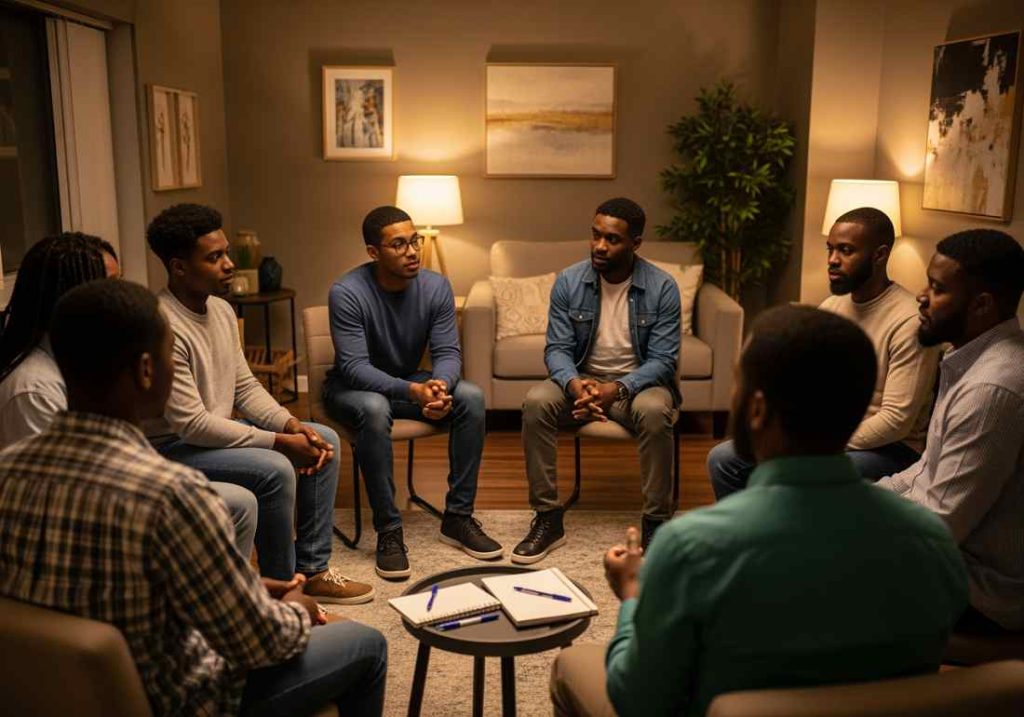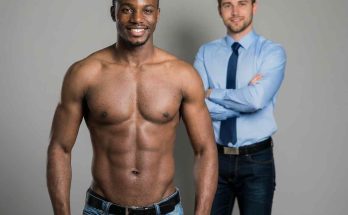By Daniel Nkado.

Many gay men describe feeling a different kind of fatigue — a deep, persistent exhaustion that does not come from doing more work. It’s more like being drained from simply existing.
There’s a strong chance that what these gay men are experiencing isn’t ordinary burnout at all, but a form of identity‑based exhaustion called Queer Burnout—chronic fatigue that comes from the ongoing effort to exist and thrive in a world that constantly marginalises them.
This guide explains the psychology behind queer burnout, outlines how this stress affects the body, and shares research-backed strategies to rebuild energy and resilience (Meyer, 20033; Frost and Meyer, 2023)5.
Queer Burnout: The simple definition
Queer burnout is a deep, ongoing state of chronic exhaustion experienced by many gay men and other marginalised groups.
It is not caused by overworking, but by minority stress— a form of the chronic stress experienced by members of stigmatised minority groups due to constantly dealing with prejudice, discrimination, and social exclusion (Meyer, 20035; Frost and Meyer, 2023)3.
🧠 How minority stress creates exhaustion
The concept of Queer Burnout is best explained by the Minority Stress Model, a foundational framework in LGBTQ+ health research pioneered by psychiatric epidemiologist Dr Ilan Meyer.
This model proposes that the higher rates of mental health issues seen among gay men and other marginalised groups are primarily due to minority stress— a form of chronic stress experienced by members of stigmatised minority groups due to constantly dealing with extra pressures.
This ongoing stress contributes to higher rates of anxiety, depression, and physical health issues in LGBTQ+ people, not because of individual weakness, but as a result of enduring persistent inequality and exclusion (Meyer, 2003)5.
People with multiple marginalised identities—such as being both LGBTQ+ and a person of colour—often face higher levels of minority stress due to dealing with overlapping stressors like racism and homophobia at the same time, making the risk of burnout and health issues even higher.

The Minority Stress Model identifies the two primary sources of chronic fatigue:
1. External Stressors: These include direct experiences of discrimination, political threats, violence, and daily microaggressions (subtle, often unintentional slights or slurs used in conversation).
2. Internal Stressors: The constant mental effort required to cope with the external world, including constant vigilance (always watching out for threats), concealment (hiding parts of yourself to fit in), and dealing with internalised stigma (unconscious assimilation of societal prejudices).
Over time, the pressure of navigating these external and internal stressors accumulates into a chronic emotional and physiological fatigue called Queer Burnout.
🩺 How minority stress affects gay men’s health
Minority stress doesn’t just affect the mind — it exerts a real toll on our physical health as well. When you’re constantly watching out for triggers or dealing with internalised negative feelings about your existence, your nervous system stays stuck in “fight or flight” mode (Meyer, 20035; Scheer et al., 2020)8.
What happens in the body:
Chronic stress causes the body’s stress response system (known as the HPA-axis) to stay hyperactive, continuously releasing the hormone cortisol. While cortisol is beneficial in short bursts, high levels over time become toxic, leading to a condition called allostatic load, which refers to the cumulative wear and tear on the body caused by prolonged exposure to stress (Meyer, 2003)3.
This situation has several negative health outcomes:
- Sleep disruption — difficulty falling or staying asleep.
- Weakened immunity — getting sick more often or recovering slowly.
- Persistent pain — tension headaches, muscle aches, or joint stiffness.
- Overwhelming fatigue — exhaustion that rest alone doesn’t fix.
- Digestive issues —stomach discomfort, bloating, or bowel changes (Meyer, 20033; Scheer et al., 2020)8.
These symptoms aren’t imagined — they’re the body’s response to living under constant pressure.
💪 5 Research-backed steps to beat queer burnout
Combating queer burnout requires building resilience and protection against minority stress. Multiple psychological and health studies support these strategies:
1. Find Stable Community Support
Strong community support reduces the harms of minority stress by providing emotional validation, practical support, and a sense of belonging. These connections lower internalised shame and nervous overdrive by sharing coping strategies and resources (like affirming care or mutual aid), and also providing a platform for people to be heard without fear of judgment.
Communities also often enable collective advocacy that addresses the root causes of stigma.

Practical steps to strengthen community connection:
- Beyond just connection, look for ways to contribute, as finding meaning and purpose in shared struggle (activism, peer support) can counteract feelings of helplessness and burnout (American Psychological Association, 20211; Scheer et al., 2020)8.
- Offer regular, low‑barrier touchpoints (drop‑ins, brief check‑ins, online groups).
- Create identity‑safe spaces with clear anti‑oppression norms and moderation.
- Combine emotional support with practical help (referrals, mutual aid, clinic signposting).
- Invest in community leadership by training, paying, and supporting peer facilitators.
2. Set firm digital boundaries
Constant exposure to triggering news, political debates, and online negativity accelerates vigilance and stress.
- Schedule limited news checks and curate your feeds to focus on supportive, affirming content.
- Unfollow social media accounts that promote constant outrage or negativity.
- Engage more with LGBTQ+-focused digital mental-health tools/resources, as this can help promote mental calm (Fowler et al., 2023)2.
3. Embrace mind-body restoration
Engage in activities that deliberately regulate your nervous system and lower chronic cortisol levels.
- Grounding Techniques: Use exercises like the Five-Senses Grounding technique (naming five things you can see, four things you can touch, three things you can hear, two things you can smell, and one thing you can taste) to immediately pull your awareness out of hypervigilance.
- Movement/Exercise: Physical activity is one of the most effective ways to burn off stress hormones and regulate the mood. Even light physical activity —like a 15-minute walk—can significantly lower stress hormones and boost mood (Naczenski et al., 2017)6.
- Mindfulness and Meditation: Mindfulness and meditation can ease stress by improving sleep and calming the amygdala’s threat response (Naczenski et al., 20176; Hytman et al., 2025)4.
4. Seek Identity-Affirming Care
Work with mental or physical health providers who are explicitly trained in minority-stress-informed care. This is crucial for addressing internalised stigma without judgment, which significantly improves mental health outcomes (American Psychological Association, 20211; Scheer et al., 2020)8.
5. Advocate for Structural Change
Contributing to inclusive policies—like anti-discrimination protections or increased LGBTQ+ visibility—is restorative. Working toward structural progress lessens the overall minority stress burden at the community level, thereby benefiting everyone (Frost and Meyer, 2023)3.
🌱 Take Action: Small steps to start today
Small “micro-interventions” that can help in gradually restoring energy:
- Permissioned rest: Take 15 minutes of guilt-free downtime—no screens, no tasks (Peel et al., 2023)7.
- Five-senses grounding: Name five things you see, four you can touch, three you hear, two you smell, and one you taste (Hytman et al., 2025)4.
- Digital boundary: Choose one daily news-check time and mute triggering accounts (Fowler et al., 2023)2.
- Observe a peer space: Spend a week quietly engaging with an LGBTQ+ group or online forum (Peel et al., 2023)7.
Bottom line: Queer burnout is a real, evidence-based response to systemic social inequalities—not a personal failure. With supportive community, healthy boundaries, affirming care, and advocacy, it is possible to beat this issue and restore balance and resilience (Meyer, 20035; Frost and Meyer, 2023)3.
Daniel Nkado is a Nigerian writer, editor, and author best known as the founder of DNB Stories Africa, a digital platform covering Black stories, lifestyle, and queer culture.
References
- American Psychological Association. (2021). APA Guidelines for Psychological Practice with Sexual Minority Persons. Apa.org. https://www.apa.org/about/policy/psychological-sexual-minority-persons.pdf
- Fowler, J. A., Buckley, L., Muir, M., Viskovich, S., Paradisis, C., Parnian Zanganeh, & Dean, J. (2023). Digital mental health interventions: A narrative review of what is important from the perspective of LGBTQIA+ people. Journal of Clinical Psychology, 79(11). https://doi.org/10.1002/jclp.23571
- Frost, D. M., & Meyer, I. H. (2023). Minority stress theory: Application, critique, and continued relevance. Current Opinion in Psychology, 51. Article 101579. https://doi.org/10.1016/j.copsyc.2023.101579
- Hytman, L., Amestoy, M. E., Ueberholz, R. Y., & Fiocco, A. J. (2025). Cultural adaptations of mindfulness-based interventions for psychosocial well-being in ethno-racial minority populations: A systematic narrative review. Mindfulness, 16, 21–41. https://doi.org/10.1007/s12671-024-02501-8
- Meyer, I. H. (2003). Prejudice, social stress, and mental health in lesbian, gay, and bisexual populations: Conceptual issues and research evidence. Psychological Bulletin, 129(5), 674–697. https://doi.org/10.1037/0033-2909.129.5.674
- Naczenski, L. M., de Vries, J. D., van Hooff, M. L. M., & Kompier, M. A. J. (2017). Systematic review of the association between physical activity and burnout. Journal of Occupational Health, 59(6), 477–494. https://doi.org/10.1539/joh.17-0050-ra
- Peel, E., Rivers, I., Tyler, A., Nodin, N., & Perez-Acevedo, C. (2022). Exploring LGBT resilience and moving beyond a deficit model: findings from a qualitative study in England. Psychology & Sexuality, 14(1), 1–13. https://doi.org/10.1080/19419899.2022.2063754
- Scheer, J. R., Harney, P., Esposito, J., & Woulfe, J. M. (2019). Self-reported mental and physical health symptoms and potentially traumatic events among lesbian, gay, bisexual, transgender, and queer individuals: The role of shame. Psychology of Violence, 10(2). https://doi.org/10.1037/vio0000241


